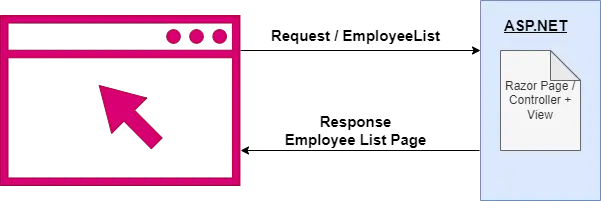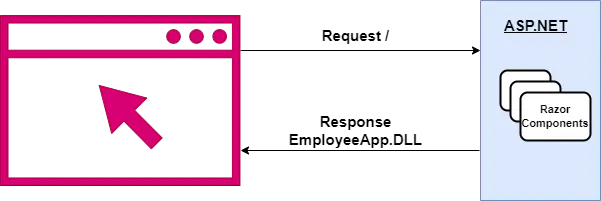Test in a live environment
Test in production without watermarks.
Works wherever you need it to.
Razor and Blazor are two of the most popular web UI frameworks for creating web apps in the Visual Studio development environment. This blog post will examine the similarities and differences between these two .NET technologies based on their syntax, interactions, benefits and drawbacks. It will also demonstrate some use cases with some code examples.
Razor is a server-side markup language that allows developers to create web pages dynamically using HTML and embedded, .NET server-side code. Razor generates web pages from Razor pages, web page template files written with C# or VB. Razor pages written with VB code use the .vbhtml file extension, and razor pages written with C# code use the .cshtml file extension.
Modern ASP.NET web applications support Razor, and it can be used in favor of traditional ASP.NET markup to generate application view components.
Blazor is a web application framework that allows developers to build interactive, clientside interfaces applications using .NET programming languages. Web applications built with Blazor are single-page applications (SPA) that execute inside of a web browser client (not ona web server). Browser-side app execution is possible thanks to WebAssembly. WebAssembly is a cross-platform instruction set library found on all modern web browsers that is capable of executing .NET source code.
With Blazor, it is possible for developers to create reusable, interactive client-side web components with C#, HTML and CSS (without needing to incorporate JavaScript). Futhermore, as these components are written in C#, developers have the flexibility to move implementation details back and forth between the client and server as source code and libraries as necessary.
Blazor fully supports the Razor syntax. You can build Blazor apps using Razor's full markup feature set: using loops, conditionals, etc. Consider the following example.
@page "/HelloWorld"
<h1>
Example Component
</h1>
@foreach(var person in People){
<h2>person.FirstName</h2>
}@page "/HelloWorld"
<h1>
Example Component
</h1>
@foreach(var person in People){
<h2>person.FirstName</h2>
}'INSTANT VB TODO TASK: The following line could not be converted:
page "/HelloWorld" (Of h1) Example Component </h1> foreach(var person in People)
If True Then
(Of h2) person.FirstName</h2>
End IfWe can see clearly that there is a relationship between Blazor and Razor. After all, Blazor's name itself is a combination of the words "browser" and "razor."
Razor and Blazor are both used to create web applications using HTML and C#. Since they are open-source and free, developers can utilize them immediately and without restriction. When developing ASP.NET web applications, we use the Razor syntax because it is more akin to ASP.NET Core and ASP.NET MVC.
Blazor builds flexible, interactive user interfaces from one or more components written with Razor syntax.
It is at this point that we must make a significant distinction with how Razor is used in Blazor: it is used to build components (buttons, page elements, etc), and not to build entire pages.
Additionally, Razor files (files with the .chtml extension) within Blazor are known formally as Razor components, not as Blazor components (although both words get used interchangably in many development circles).
Razor works within MVC applications to serve entire pages to the browser.

Razor Pages in Action
When a user clicks a button or a link, the browser sends a request to the server, which hits the database, retrieves the .cshtml Razor Views (or Razor page), mashes the data and markup together, and returns the entire thing to the browser (re-rendering the entire page).
Blazor, on the other hand, allows you to create an entire web page using a series of smaller components written in Razor syntax.

Blazor in Action
This illustrates the operation of Blazor WebAssembly (Blazor WASM).
The first call to your Blazor WASM application returns the complete program, including all of the components you've defined, much like a Single Page Application created using JavaScript.
Now that the browser has access to these elements, it can display, conceal, and update them in response to information and events.
In this way, Blazor apps are more similar to the applications you'd develop using a "contemporary" JavaScript library/framework such as Vue or Angular. Blazor applications perform network calls to a backend while running in the browser to retrieve and send data.
Now, let's discuss some pros and cons of the Blazor app and Razor View engine.
When it comes to creating interactive web apps built on the .NET framework, Blazor and Razor are both extremely well-liked. These technologies offer a novel transition from utilizing C# as the primary programming language for standard JavaScript projects.
Here are a few benefits and drawbacks to think about when creating a web application using Razor or Blazor.
Razor can handle API logic and server-side templating, but it cannot handle client-side logic that is not JavaScript-based. Blazor allows programmers to handle both client and server-side functionality with just C#. Razor is a markup syntax for templates. It incorporates server-side code into the HTML. Blazor, on the other hand, is an SPA framework that can run on either Blazor WebAssembly or the Blazor Server, depending on the situation.
IronPDF provides the easiest way to create, read, update, and manipulate PDF files in both Razor and Blazor applications. IronPDF is a part of Iron Software's Iron Suite which consists of five useful libraries that is helpful for creating Razor or Blazor web apps that with Excel, PDF, Barcodes, QR Codes, and images.
Iron Suite is available free for personal use. For more information about obtaining a commercial license, please click here.
9 .NET API products for your office documents








